Section 2 Labour Market
5. Average earnings
Tables 5(a), 5(b) and 5(c) display the gross median hourly earnings for full-time employees for all industries, and for manufacturing and service industries separately. Figures are given for male, female and all employees. Chart 5 illustrates the changes in median hourly earnings of full-time employees between 2004 and 2005.
During 2005, the hourly earnings (including overtime and shift pay) of full-time employees in London were higher than any other UK region at �14.51. Earnings in the South East were next highest at �11.28 per hour. This compares to an average of �10.79 per hour for the UK as a whole. The lowest earnings during 2005 were recorded in Northern Ireland at �9.67 per hour and the North East at �9.70 per hour. The highest earnings growth 2004 to 2005 was in the East Midlands at over 5 per cent compared to the UK average of 3.3 per cent.
The gender pay gap, in terms of the ratio between female and male hourly earnings, has been decreasing in all regions. In 2005, average female hourly earnings were 94 per cent of male earnings in Northern Ireland, compared with less than 90 per cent for each other region, and 86 per cent for the UK as a whole.
However, comparisons of the value of hourly earnings between regions as well as over time should be interpreted with caution. These estimates do not take account of regional variations in the cost of living and, to that extent, do not represent the true �buying power� of these earnings.
Chart 5
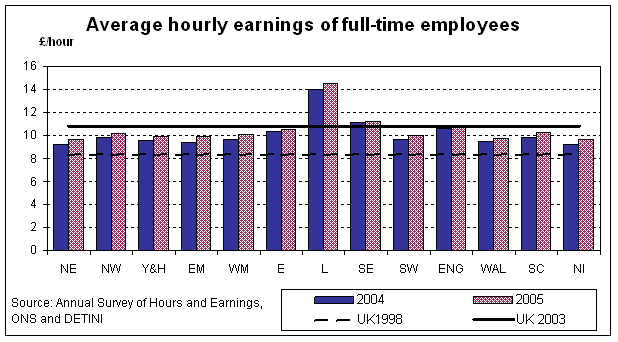
�
6. Employment
Chart and Table 6(a) detail the number of people of working age who are in employment (by their region of residence) while Chart and Table 6(b) illustrate this as a proportion of working age people (aged 16 to 59[women]/64[men]).
During winter 2005, about three-quarters of working age people in the UK were in employment. The largest proportions of the resident working age population in employment were in the South East and South West, with 79 and 78 per cent respectively. Throughout the period in Table 6(b), the South East, South West and East of England consistently have the largest proportion of working age people in employment of all UK regions. The smallest proportions during winter 2005 were in London and Northern Ireland, at just under 70 per cent each (almost 5 percentage points below the UK rate).
Table 6(c) and Chart 6(c) cover total number of employee jobs in the UK and each region�s share of this total. London is the biggest single labour market with around 15 per cent of all UK employee jobs. The level of employee jobs grew most quickly in Wales, with an increase of over 7 per cent between December 2001 and December 2005. Yorkshire and the Humber showed the next largest rise, of about 6.4 per cent.
High levels of commuting should be taken into consideration when looking at London�s share of the UK labour market. The LFS indicates that in autumn 2003 approximately 20 per cent of employees in London commuted in from another region.
Chart 6(a)
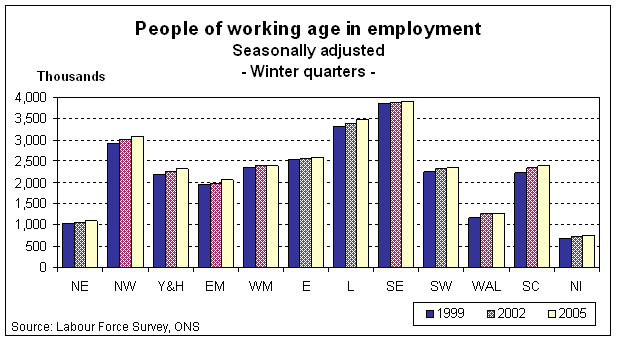
Chart 6(b)
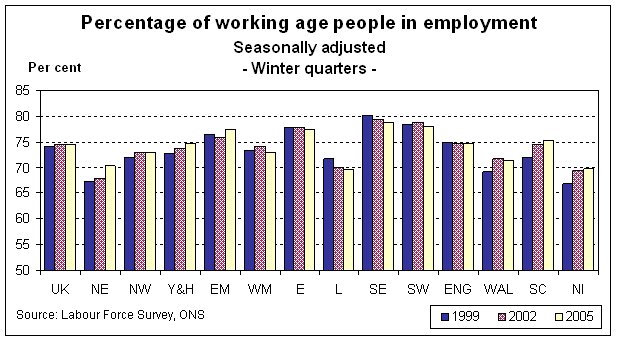
Chart 6(c)
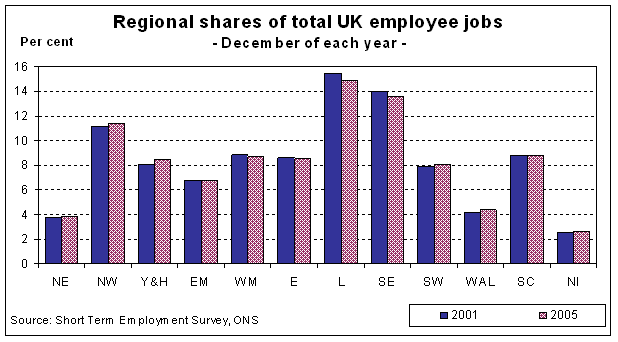
�
7. Unemployment
UK unemployment is measured by the Labour Force Survey (LFS). Chart 7(a) shows the seasonally adjusted unemployment rate between 1999 and 2005 (winter quarters).
During winter 2005, the unemployment rate was lowest in the South West at 3.6 per cent, as compared to a rate for the UK at just over 5 per cent. During this time, London had the highest rate of unemployment of any UK region at 7.5 per cent.
Map 7(b) shows that between winter 1999 and winter 2005 unemployment rates decreased in most UK regions. The exceptions being London, South East and East of England where unemployment increased by 0.2, 0.5 and 0.6 percentage points respectively. The largest falls were 2.7 percentage points in Northern Ireland and 2.1 percentage points in Wales � compared with an overall decrease across the UK of 0.7 percentage points.
Chart 7(a)
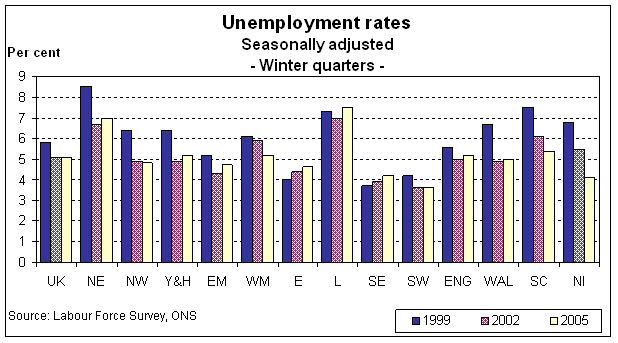
Map 7(b)
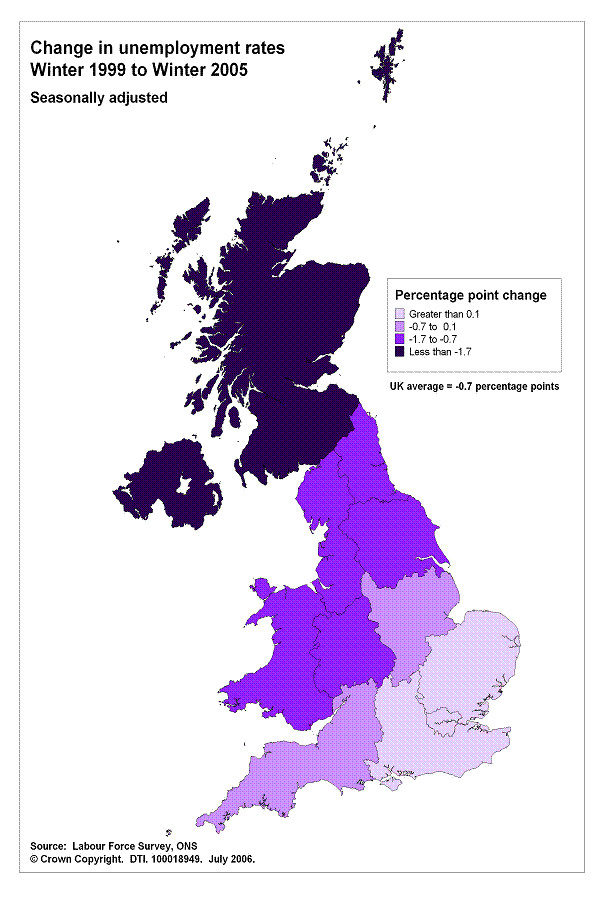
�
8. Claimant count
The claimant count is the number of people claiming unemployment related benefits, such as Job Seeker�s Allowance, taken from monthly records. Table 8(a) gives the claimant count rate as a proportion of workforce jobs (plus claimants) in the region.
Claimant count rates during March 2006 were highest in the North East with a rate of 4.2 per cent, and lowest in the South East and the South West, at 1.9 and 1.8 per cent respectively. All regions show a decrease in the proportion of claimants in the workforce between March 1999 and March 2006, with the largest drop of 3.6 percentage points in Northern Ireland.
Table and Chart 8(b) detail the percentage of all claimants in receipt of the Job Seeker�s Allowance benefit for a year or more (computerised claims only; approximately 1 per cent of claims are dealt with manually, and these are excluded from the figures). Over the UK as a whole, this proportion has fallen from about 25 per cent of all claimants in March 1999 to just over 14 per cent in March 2005. Northern Ireland had the largest decrease during this period by over 22 percentage points. The highest percentage of long-term claimants during March 2005 was also in Northern Ireland, where just under 21 per cent of benefit recipients had been claiming for a year or more.
Chart 8(b)
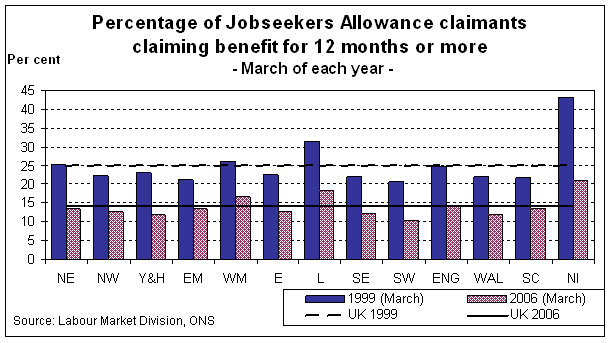
�
9. Educational and vocational attainment
The indicators included within this section relate to the Department for Education and Skills� (DfES) PSA and Learning and Skills Council (LSC) targets for England, although data are also provided for Wales, Scotland and Northern Ireland. Refer to Definitions for a full description of these targets.
Table and Chart 9(a)(i) detail the percentage of 16-19 year olds qualified to
the equivalent of NVQ level 2 (e.g. 5 GCSE passes at grade A*-C) or above. By
autumn 2005 across the UK as a whole, Scotland had the highest proportion of
16-19 year olds qualified to NVQ level 2 or above at 74.4 per cent and the North
East had the lowest proportion at 58.3 per cent.
Between the autumns of 1999 and 2005 Wales had the largest change in proportion
of 16-19 year olds at level 2 or above with an increase of over 5 percentage
points in comparison with a UK increase of 1.6 points.
The figures in Table 9(a)(i) are based on a relatively small sample of people and so can be subject to high sampling variation. In light of this, the DfES has developed a new method to measure the attainment level of 16-19 year olds using matched administrative data, rather than sample surveys . Using this method, the proportion of 19 year olds in 2005 qualified to NVQ level 2 or above in England was 69.8 per cent, compared to 65.1 per cent from the sample survey (the LFS). The DfES and the LSC share a PSA target to increase the proportion of 19 year olds in England who achieve at least NVQ level 2 by 3 percentage points between 2004 and 2006, and a further 2 percentage points between 2006 and 2008. At the time of going to press, the new method would not cover the whole of the UK.
Chart 9(a)(i)
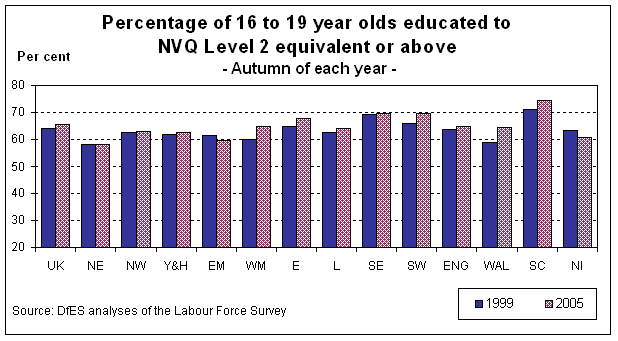
Tables and Charts 9(a)(ii) and 9(a)(iii) show the proportions of young adults
(19-21 year olds) educated to NVQ level 2 or higher and educated to NVQ level 3
(equivalent to 2 A level passes at grade A-C) or higher. By the autumn of 2005,
the proportion at level 2 or above was lowest in Wales with 69.7 per cent and
the lowest proportion at level 3 or above was in Northern Ireland at 42.5 per
cent. Scotland had the highest proportion in both instances with 82.2 per cent
of 19-21 year olds at level 2 or above and 59.5 per cent at level 3 or above.
Wales had the largest change in proportion of young adults at level 2 or above with a 6 percentage point increase between the autumns of 1999 and 2005. Similarly, the North East had the largest change at level 3 or above with an increase of 7 percentage points in the same period.
Chart 9(a)(ii)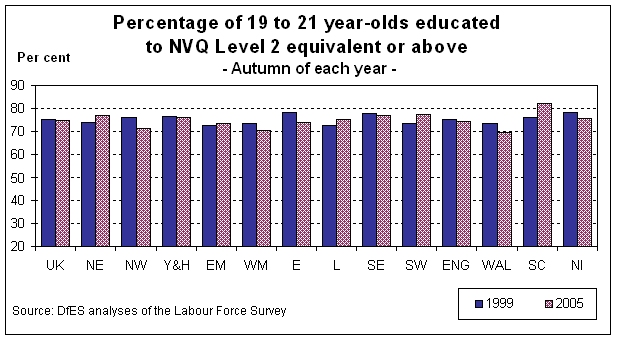
Chart 9(a)(iii)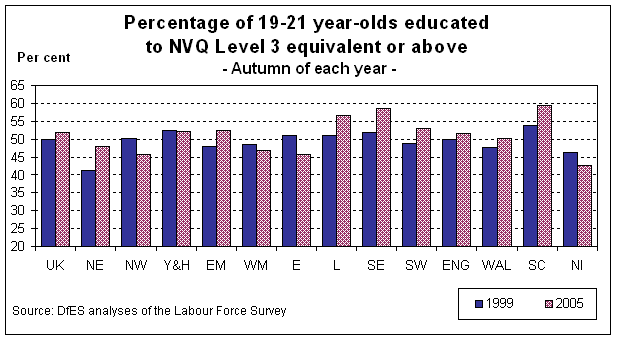
Tables and Charts 9(b)(i) to
9(b)(iii) display the proportions of economically
active adults qualified to at least NVQ level 4 (equivalent to degree level),
level 3 and level 2 respectively. Across the UK, in autumn 2005, over 31 per
cent of economically active adults were qualified to NVQ level 4 or above.
However, the achievement profile across regions is uneven; London and Scotland
perform especially well (41.2 and 35.5 per cent respectively) but the North East
and Yorkshire and the Humber relatively poorly (both 26 per cent).
Achievement at NVQ level 3 displays a similar pattern. Over half (51.9 per cent) of economically active adults in the UK have level 3 or above, with the highest proportion in Scotland (58.1 per cent) and the lowest in Yorkshire and the Humber (47.8 per cent). Table 9(b)(iii) shows Scotland having the highest proportion of adults qualified to NVQ level 2 or above (77.5 per cent) and Yorkshire and the Humber as having the lowest (70.8 percent).
Between the autumns of 1998 and 2005, the proportion of adults with level 2 or above grew fastest in the North East and West Midlands (9.8 and 9.1 percentage points respectively). In the same period, these two regions displayed the highest growth in the proportion of adults with level 3 or higher (8.6 and 7.5 percentage points respectively). The West Midlands also showed the highest growth in proportion of adults at level 4 or above with a 6.9 percentage point increase in the same period.
Chart 9(b)(i)
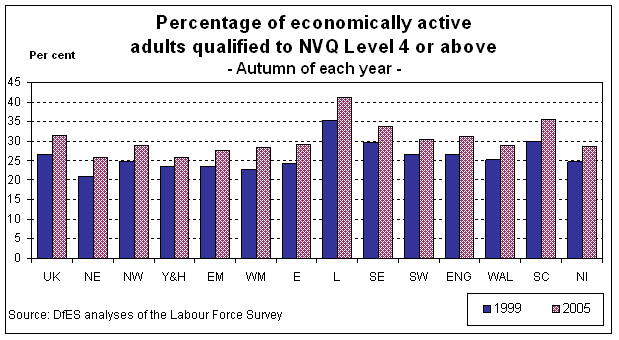
Chart 9(b)(ii)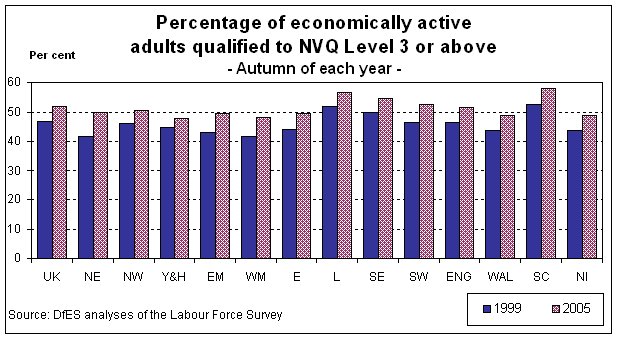
Chart 9(b)(iii)
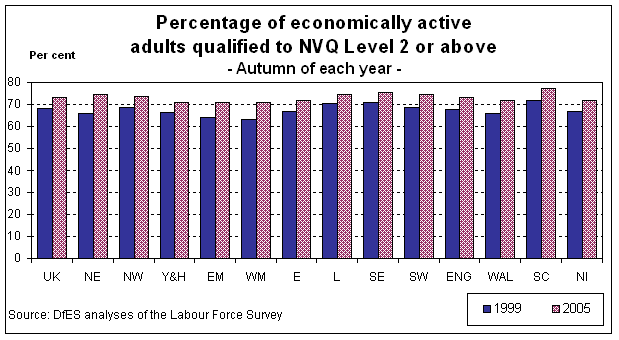
Chart and Table 9(b)(iv) show the proportion of economically active adults in each region who have no qualifications. In the autumn of 2005, fewer than 1 in 10 adults in the UK had no qualifications. This proportion was broadly repeated across the English regions, Scotland and Wales but was exceeded in Northern Ireland where roughly 1 in 6 adults had no qualifications (16.5 per cent). The lowest figures were in the South East and South West, where each respectively had just 6.8 and 6.9 per cent of adults with no qualifications. Between the autumns of 1998 and 2005, the North East saw the greatest drop in proportion of adults without qualifications (5.9 percentage points).
These estimates should be interpreted with care. In particular, the results for London and the South East say as much about the economic �pull� of these regions and the mobility of people with certain qualifications, as they do about the social and demographic characteristics of other regions.
Chart 9(b)(iv)
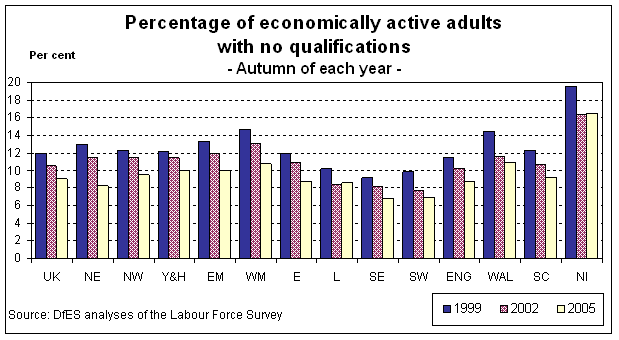
Roughly 1 in 6 employees in the UK received job related training in the previous
4 weeks (15.9 per cent) as shown in
Table and Chart 9(c). This pattern is
broadly repeated across all regions, except for Northern Ireland, where only 1
in 10 received training (9.8 per cent).
Chart 9(c)
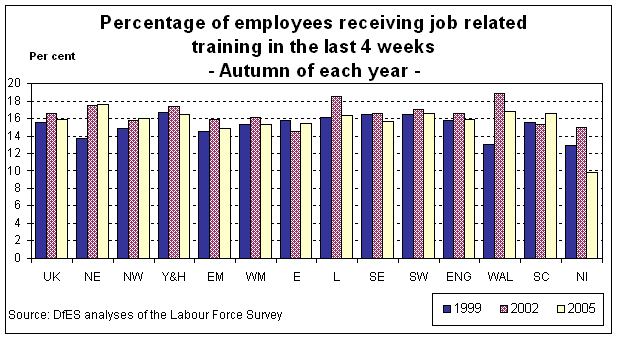
�